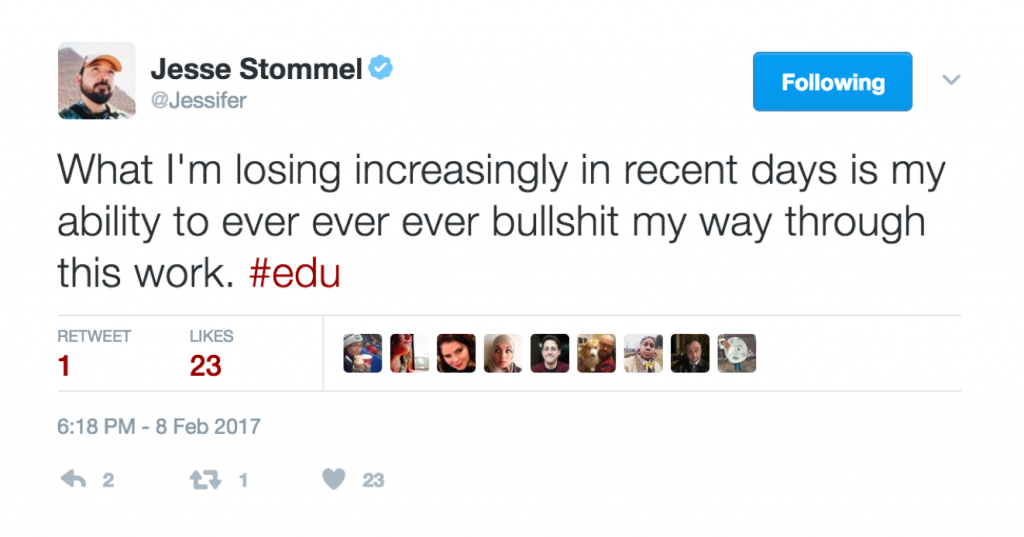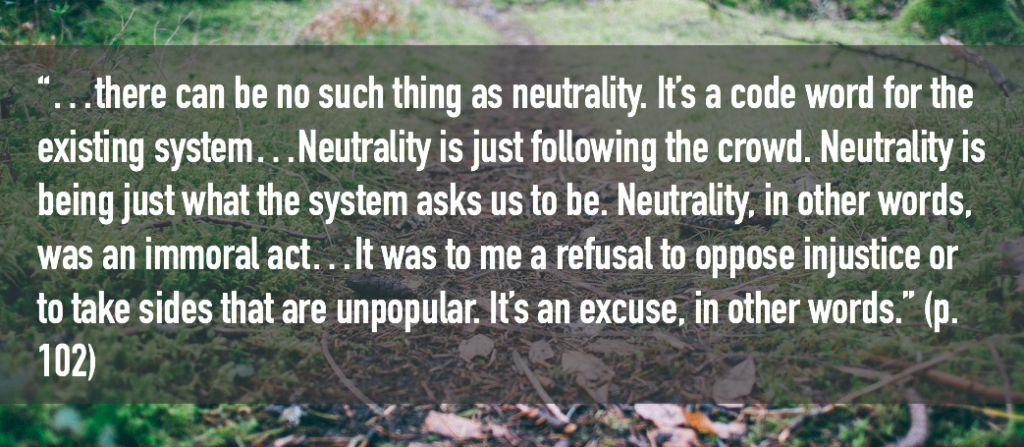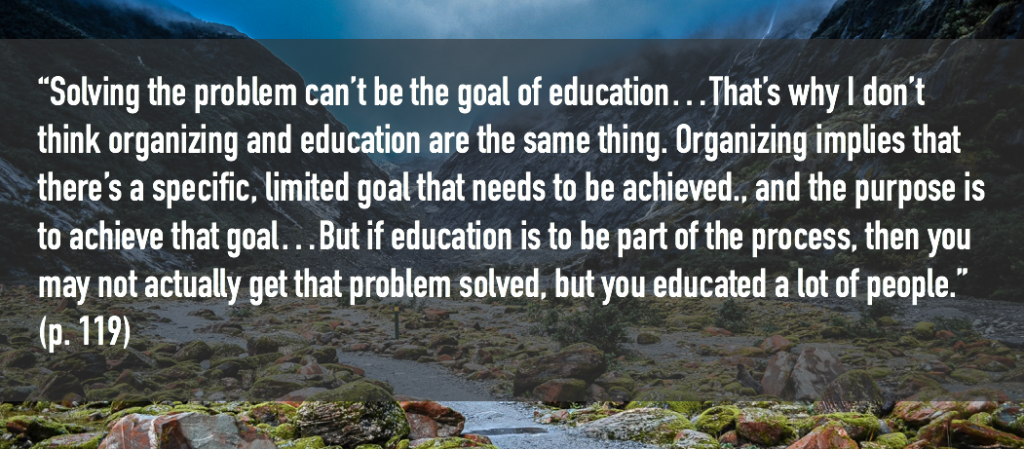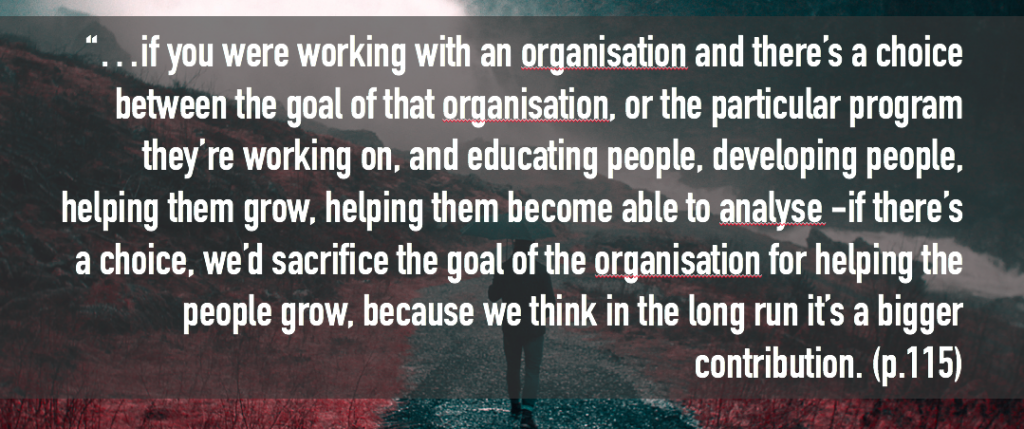“it should be necessary to start”: Critical digital pedagogy in troubled political times
I want to say first that this was a difficult talk to assemble, for many reasons. I found it difficult to formulate a concise picture of all that is happening in the US and its impact on higher education, and with an eye toward a broader geopolitical landscape, without keeping us here all day. From that perspective, I hope that we will treat this presentation as the start of a conversation, one of many conversations starting among educators, administrators, and students. I should also say that my primary role at Middlebury is that of an administrator and, though I talk about some things broadly, I plan to bring my perspective about how academic and digital learning administrators may be thinking about these issues and how to respond.
It’s also been one of the most ever-changing talks I have assembled. The constant assault, the blitzkrieg, of Trump’s administration has made issues and their responses hard to pin down. This is, of course, on purpose. Blitzkrieg is intended to knock people on their heels by attacking from multiple fronts and attacking quickly. It’s meant to divide our resistance, keep us from organizing on one issue, keep us in a constant state of shock. Personally, I have suffered sleepless or nightmare-filled nights and crises about my work. As the response to Trump’s election–both by those who supported him and those who opposed him–intensifies, the outlook feels bleak.
But this will be a hopeful talk as well. The racism, xenophobia, sexism, self-interest, war-mongering that has been emboldened by Brexit or Trump’s election has always been around. That we are forced to confront it, that we have tools and new connections that help us resist, means we have an imperative for action. The goal of this talk, of this resistance, is hope toward action. Paulo Freire, in Pedagogy of Hope said: “…all liberating practice—which values the exercise of will, of decision, of resistance, of choice, the role of emotions, of feelings, of desires, of limits, the importance of historic awareness, of an ethical human presence in the world, and the understanding of history as possibility and never as determination—is substantively hopeful and, for this reason, produces hope.”
The foundational premise of today’s talk is this: The work of education can never look anything like it did before. Our work cannot look like it did before. This tweet from Jesse Stommel hit home for me:
 That’s why the title for this talk is “it should be necessary to start,” which is a line from the book, We Make the Road by Walking. It was the first book I read after Trump’s election and, for me, it was the beginning of a healing and reorientation process of sorts (I read it as part of Bryan Alexander’s excellent book club). We Make the Road is a spoken book, transcribed from a conversation between critical education giants Myles Horton and Paulo Freire. Myles Horton, whose work began and focused in the Appalachian Mountains of Tennessee, started the Highlander School. The Highlander School, among other things, was part of the labor and Civil Rights movements in the US in the 1950s primarily (the school’s ties with the Civil Rights movement would force its closure in 1961 but it later reopened and is still in operation today). Paulo Freire, an educator focused primarily on literacy and liberatory education in his and my home country of Brazil, became a leader of state and national literacy efforts before a military coup forced him into exile. He wrote his most famous book, Pedagogy of the Oppressed, in 1968 while living in Chile. After some time at Harvard, he returned to Brazil to continue his work.
That’s why the title for this talk is “it should be necessary to start,” which is a line from the book, We Make the Road by Walking. It was the first book I read after Trump’s election and, for me, it was the beginning of a healing and reorientation process of sorts (I read it as part of Bryan Alexander’s excellent book club). We Make the Road is a spoken book, transcribed from a conversation between critical education giants Myles Horton and Paulo Freire. Myles Horton, whose work began and focused in the Appalachian Mountains of Tennessee, started the Highlander School. The Highlander School, among other things, was part of the labor and Civil Rights movements in the US in the 1950s primarily (the school’s ties with the Civil Rights movement would force its closure in 1961 but it later reopened and is still in operation today). Paulo Freire, an educator focused primarily on literacy and liberatory education in his and my home country of Brazil, became a leader of state and national literacy efforts before a military coup forced him into exile. He wrote his most famous book, Pedagogy of the Oppressed, in 1968 while living in Chile. After some time at Harvard, he returned to Brazil to continue his work.
In the early stages of the book, as Freire and Horton are discussing the spoken format of the book, Freire remarks that they will make the road by walking, meaning that the book will emerge from their conversations, and he adds what seems like an offhand remark that “in order to start, it should be necessary to start.” “It should be necessary to start” is a phrase that stuck with me. With Trump’s election, educators are responding to conditions that make resistance necessary. Though many of the injustices we’re seeing in the open have always been operating under the surface, their manifestation makes it necessary to start. Today, I will be highlighting some of the reasons it is necessary to start, then identifying some ways in which educators and administrators are starting.
The question on many people’s minds over the last few months has been, “What will Trump’s presidency mean for education?” I could share a bunch of slides about this, but I narrowed things down to two slides (each with a link to an example or related story):
- Changes to student aid, more private lending and more debt on the heads of individual students (link)
- Cuts to personnel and funding in the US Department of Education, eventual elimination of the office (link)
- Funding funneled to for-profit, private, and charter education (link)
- Funding stripped from specific areas of study (e.g., women’s studies, environmental science) (link)
- Greater movement from Liberal Arts education to training and workforce preparation (link)
- Disappearing federal regulations (e.g., Title IX) (link)
- Repeal of DACA, immigration enforcement against undocumented students (link)
- Immigration/refugee ban will continue to impact faculty and students (link)
- Greater surveillance (link)
- Campuses as sites of unrest (e.g., Berkeley protests,**and, just as of last night, Middlebury protests against Charles Murray**. Also campuses now seeing increased hate crimes against Muslim and Jewish students, students of color, LGTBQ+ students. SPLC is keeping a list of hate crimes)(link)
Some things in the list are new dangers to our students and to education (e.g., repealing of DACA protections) but some started even before Trump was president. I’m not naïve about Obama’s Department of Education, or any that preceded it (*cough* Spellings Report *cough*) and their sometimes-negative impacts on education. But this growing list of impacts of the Trump+Session+DeVos+Republican Congress agenda is really scary.
This is the work of education—the work of critical educators, critical pedagogues, and for us in this room, critical digital pedagogues. Jesse Stommel defines critical pedagogy as “an approach to teaching and learning predicated on fostering agency and empowering learners.” It is an approach that intensely questions power structures, resists the banking model of education that Freire discusses in Pedagogy of the Oppressed. And, if you see yourself as a digital pedagogue, or a digital learning person, you should be looking to foster opportunity for agency, remove barriers for the digital in students’ lives, and deeply question technology at every turn. You should be asking how “the digital” factors into theTrump+Session+DeVos+Republican Congress agenda and what our response should be.
I am encouraged that critical digital pedagogues are already having these conversations, many in digital spaces. We need more of this. We should be thinking critically about how the digital does harm and creates risk for our students, for our view of the goals of education. But we should also be thinking about how the digital can augment this important work. I love what Kate Bowles said: “This is a time for critical educators to work together in new ways to address what’s newly at stake. To me it’s encouraging to be reminded by Horton & Freire that activists have always collaborated, that conversations have been the basis of growth as much as harm, that ideas come into focus when we talk. And maybe we’ve forgotten in the turmoil of bitterness, malice and panic that our online networks are there to let the world know what we have to say to one another.”
Now, the work of critical digital pedagogy, this political work, is not safe. Last year, a website Professor Watchlist (sorry, not linking to it) emerged as one of many threats to “activist” and political work in education. When this site emerged, a lot of academics self-reported to the site–a show of solidarity with those already listed. While this show of solidarity was nice, we also need to remember that some among us are less safe–that their participation in critical work is less safe. We need to listen to their concerns and leverage our connections in support and protection of their work.
As I mentioned before, the Horton & Freire book was helpful to me as I began to reorient myself in this new political, social, and educational context. I’d like to draw attention to three lessons I took away from the book, as a framing for how I think about the work ahead of us.
Lesson 1: Neutrality is immoral
I wrote a blog post about this, so I will refer you to go read that, instead of repeating myself here. The tl/dr version is: Education cannot be neutral because, in order to educate or to work in education, you have to have a view of what roles education should play in students’ lives. Working toward that is not a neutral act. And we have to see the injustices our students face and help to fight against those.
Lesson 2: Solutionism decomplexifies too much
Freire and Horton have a conversation about education versus organizing. With organizing, you are working toward a very specific outcome. Education will be more open-ended, more purpose-driven than outcome-driven. As we think about the work of education today, especially as we see the problems our students face, we need to resist the urge to solve all the problems but instead to work alongside students toward a liberatory education. As Lilla Watson, the Aboriginal activist from Australia, said: “If you have come here to help me, you are wasting your time. But if you have come because your liberation is bound up with mine, then let us work together.” I couldn’t describe better why critical pedagogues need to steer away from solutionism.
Lesson 3: What can be done inside institutions? (ok, not really a lesson so much as a reflection)
I’ll admit that I have been struggling with my role at my institution since the election. I wrestle with the question of whether or not we can really do the work of resistance and criticism from within institutions. I’m a sociologist who recognizes the power of systems and institutions. I have spent most of my career as an institution-based professional and administrator. But I’ve always created programs and hired people who push back on traditional strictures of an institution (sometimes putting my job security at risk).
Audrey Watters’ beautifully captures the tension we feel in digital learning / educational tech circles between what we feel drawn to do and the “mission” of our institutions: “Do our technologies or our stories work in the interest of justice and equity? Or, rather, have we adopted technologies for teaching and learning that are much more aligned with that military mission of command and control? The mission of the military. The mission of the church. The mission of the university.”
I am going to share some examples of critical digital work and many of these examples can be framed in terms of the tension Audrey describes. Chris Gilliard’s research on digital redlining at universities, for example, brings into question what we mean when we talk about students’ educational experiences (and what information students have access to as part of that) and universities’ command and control needs.
Digital redlining: According to Chris and his research partner Hugh Culik:
“Digital redlining arises out of policies that regulate and track students’ engagement with information technology. Acceptable use policies (AUPs) are central to regulating this engagement. To better understand how digital redlining works at community colleges, we sampled acceptable use policies from across the range of Carnegie Classifications. These policies, like the HOLC maps, create boundaries. The boundaries not only control information access and filtering, but also they determine methods of collection and retention of student data and how data is passed on to third parties. The modern filter not only limits access to knowledge, but it also tracks when people knock against these limits. In this environment, curiosity looks a lot like transgression.”
Digital redlining is about denying access, taking away students’ agency in digital spaces, often as part of a control and contain approach to digital services. Think about the Learning Management system and how it denies students’ agency. Think about your university’s acceptable use policies and what behaviors they try to control.
Tensions about student agency and institutional control certainly arose at Middlebury when my office launched a Domain of One’s Own initiative. People asked, “But what if students create something we don’t like? Something that doesn’t reflect well on us?” I imagine similar conversations happen at any institution considering a domains project. This is precisely WHY we need a domains project–as a first step in re-routing how we think about student access and agency in digital spaces. It also opens up conversations about student data–who has it, who controls it. As we develop our Domain of One’s Own initiative, we are looking to accompany it with programming on digital and personal data literacies. Where is your data? How is it being used against you? What is your intellectual property online and what puts it at risk? These are the next steps for Middlebury’s Domain of One’s Own initiative.
This conversation is particularly relevant as we think about Trump’s Muslim ban and the push for deportations of undocumented immigrants. Last week, a DACA student was detained by ICE–the first of such transgressions against students who have been protected by DACA up to this point (and just this week, another DACA student who spoke out against the Trump administration, was arrested by ICE). These incidences call into question not just the ways students might be denied access to services, infrastructure, information, education but also the ways in which their access to our campuses (physical and digital) may not be safe for them, may be used against them. This leads me to…
Digital sanctuary: This is an emerging idea and I would love this group’s input on what would go into a digital sanctuary strategy. Digital sanctuary, which builds from ideas in the sanctuary cities and campuses movement, recognizes that physical and digital spaces may not be safe for some of our students. A digital sanctuary initiative would look for ways to minimize risks to students associated with the technologies they encounter at our institutions. I was excited to see that the University of Edinburgh is taking student data seriously. Here are some ideas for what a digital sanctuary approach might look like (more posts on this later):
1) Do an audit of student data repositories & policies associated with third party providers. Make sure you are aware of and have documented every “place” student data goes and what their policies are on handling your students’ data.
2) Have a standard and well-known policy about how to handle external inquiries for student data and information. I’m slightly less worried about rogue university staff handing out student data in a way that puts undocumented students at risk and more worried about coercion and intimidation that could yield problematic results without clear guidelines for people to follow. This may not necessarily mean that people can choose not to give out specific data from a sanctuary campus—we may be legally bound to do so—but that there is a process for giving data (and what data can and should be given) to law enforcement and immigration enforcement. People should understand how and when they can say no to inquiries about students, and campuses should investigate the legal limits of their non-compliance with such inquiries.
3) Provide audit of data to any individual who wants to know what data is kept on them, how it is kept, where it is kept, and who else has access. That is, if a student wants to know more about how their data is kept, what data we keep, and who has access to it, we should be able to give them that information.
4) Have clear guidelines and regulations for how data is communicated and transmitted between offices. How can we better protect student data as we transmit it between people who should have access (e.g., maybe not via email)? We should have clear policies and guidelines about protection of student data on devices. I was really proud of Stanford’s School of Medicine when they undertook a major initiative to protect devices used by faculty, staff, and students–via services like two-factor authentication and encryption services–to better protect student and patient data. We need more of that kind of thinking.
5) Take seriously the data policies of your third party vendors. Don’t work with vendors whose contracts stipulate that they can use and share your students’ data without your consent. Common Sense Media has some good resources on this: https://privacy.commonsense.org/
6) Closely examine and rethink our student tracking protocols. How necessary are the dashboards? How problematic are our “acceptable use” policies? How long do we need to keep data? Do we really need all of the data we’re collecting?
It’s pretty straightforward to think about these questions and opportunities in light of undocumented students. I wonder if we’re also thinking about them in terms of other students who experience greater risk at our institutions. LGTBQ+ students. Students of color. Students facing poverty and economic instability. We are sold learning analytics—dashboards, percentages, key indicators—at every turn in ed tech. What if we decided that the risk to students of those tools was greater than the benefits?
I also want to mention Jeremy Knox’s Learning Analytics Report Card project. It has the right instincts—to give agency to learners around their data and to question the ways in which Learning Analytics are manifested and are used.
Web/digital literacies: We have a lot of work to do here. As my dear and brilliant colleague Mike Caulfield wrote: “Much web literacy we’ve seen either asks students to look at web pages and think about them, or teaches them to publish and produce things on the web. While both these activities are valuable, neither addresses a set of real problems students confront daily: evaluating the information that reaches them through their social media streams. For these daily tasks, student don’t need long lists of questions to think about while gazing at web documents. They need concrete strategies and tactics for tracing claims to sources and for analyzing the nature and reliability of those sources.” Mike, who produces good ideas faster than most people, wrote an open textbook called Web Literacy for Student Fact-Checkers, which is part of the curriculum for his Digital Polarization project with the AASCU. It’s cool stuff and we need more of this kind of thinking. The project will: “put together both a curriculum that encourages critical reflection on the ways in which our current digital environment impacts civic discourse, and to provide a space for students to do real work that helps to address the more corrosive effects of our current system.”
Antigonish 2.0: Bon Stewart is one of my heroes. As part of the Horton/Freire book club, she wrote this fantastic post about Temporarily Embarrassed Millionaires. In the post, she drew connections between the Horton’s Highlander work and a similar initiative in the Canadian Maritimes called Antigonish. Bonnie proposed that now is the time for Antigonish 2.0. Go read her proposal and join the #Antigonish2 movement. Bonnie’s plan crosses the in-institution and out-of-institution divide nicely and it seizes the power of the networked critical (digital) pedagogues. To repeat what Kate Bowles wrote: “This is a time for critical educators to work together in new ways to address what’s newly at stake. To me it’s encouraging to be reminded by Horton & Freire that activists have always collaborated, that conversations have been the basis of growth as much as harm, that ideas come into focus when we talk. And maybe we’ve forgotten in the turmoil of bitterness, malice and panic that our online networks are there to let the world know what we have to say to one another.”
In large part, that is really what this talk is about. It’s about widening and deepening the network. We need each other—I have so much to learn from all of you—and I hope that our conversations will progress to ways to move forward together. It is necessary to start. Let’s start.



Thank you again from behalf of all of us in Digital Education in Edinburgh for your fantastic, heartfelt talk last week, Amy. We really appreciated both how difficult it is to get a handle on all the things that are going on right now in the US, and that you were able to offer such a thoughtful perspective despite that difficulty. Digital sanctuary has struck a chord here – conversations continue…